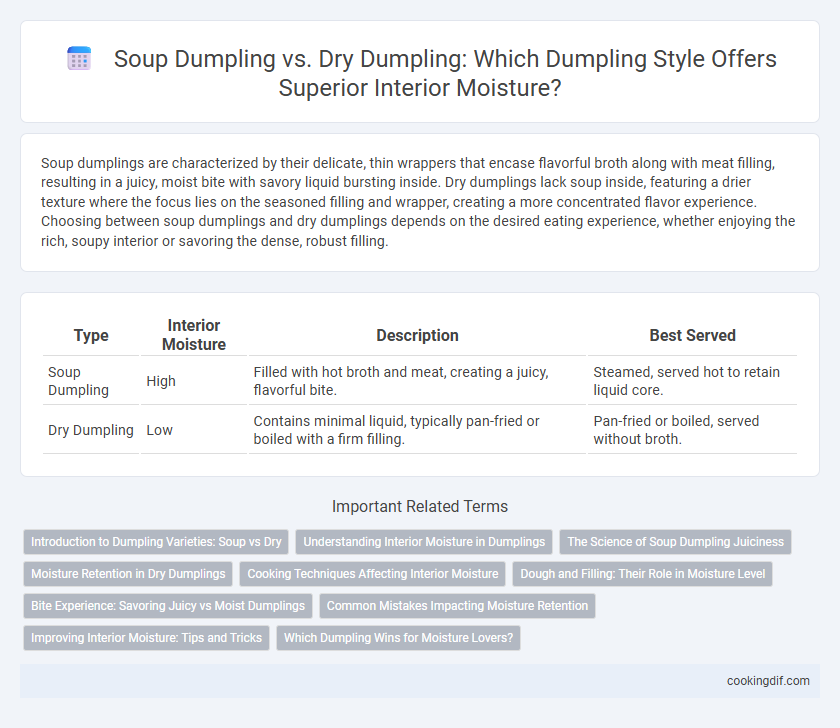Soup dumplings are characterized by their delicate, thin wrappers that encase flavorful broth along with meat filling, resulting in a juicy, moist bite with savory liquid bursting inside. Dry dumplings lack soup inside, featuring a drier texture where the focus lies on the seasoned filling and wrapper, creating a more concentrated flavor experience. Choosing between soup dumplings and dry dumplings depends on the desired eating experience, whether enjoying the rich, soupy interior or savoring the dense, robust filling.
Table of Comparison
| Type | Interior Moisture | Description | Best Served |
|---|---|---|---|
| Soup Dumpling | High | Filled with hot broth and meat, creating a juicy, flavorful bite. | Steamed, served hot to retain liquid core. |
| Dry Dumpling | Low | Contains minimal liquid, typically pan-fried or boiled with a firm filling. | Pan-fried or boiled, served without broth. |
Introduction to Dumpling Varieties: Soup vs Dry
Soup dumplings, also known as xiao long bao, feature a delicate, thin dough encasing a flavorful broth and minced meat, delivering a burst of savory interior moisture upon biting. Dry dumplings, in contrast, have a denser filling with minimal liquid, relying on sauces or dips to enhance flavor and moisture. The key distinction lies in the internal moisture content, with soup dumplings offering a juicy, soupy experience and dry dumplings providing a firmer texture and concentrated taste.
Understanding Interior Moisture in Dumplings
Soup dumplings contain a gelatin-rich broth that melts during steaming, creating a juicy interior bursting with savory liquid. Dry dumplings have a typically firmer filling with minimal moisture, offering a chewier texture without the soupy effect. Understanding the moisture content helps distinguish the mouthfeel and flavor experience between these two popular dumpling varieties.
The Science of Soup Dumpling Juiciness
Soup dumplings achieve their signature juiciness through gelatin-rich broth solidified into aspic, which melts upon steaming, releasing interior moisture that enhances tenderness and flavor. Dry dumplings lack this gelatin infusion, resulting in a denser texture without the burst of savory juice. Understanding the collagen conversion in the aspic highlights the critical role of interior moisture retention in differentiating soup dumpling succulence from dry varieties.
Moisture Retention in Dry Dumplings
Dry dumplings retain moisture through a tightly sealed dough that traps steam during cooking, preventing excessive water loss. The absence of soup inside allows the filling to maintain a denser, juicier texture as natural juices are concentrated. This moisture retention technique creates a satisfying bite without the liquid burst found in soup dumplings.
Cooking Techniques Affecting Interior Moisture
Cooking techniques significantly impact the interior moisture of soup dumplings versus dry dumplings, with soup dumplings relying on the gelatinized broth encased within a delicate wrapper to create a juicy burst upon biting. Steaming is the preferred method for soup dumplings, preserving the soup's liquid state inside, while dry dumplings benefit from pan-frying or boiling, which cooks the filling thoroughly but results in a drier texture. Controlling cooking time and temperature is critical to maintaining the optimal interior moisture, ensuring soup dumplings do not lose their characteristic broth and dry dumplings remain moist without becoming soggy.
Dough and Filling: Their Role in Moisture Level
Soup dumplings feature a thin, delicate dough that encases a gelatin-rich filling, which melts into a flavorful broth during steaming, ensuring a moist interior. Dry dumplings typically use a thicker, sturdier dough with a firmer filling that retains less moisture, resulting in a denser texture. The balance between dough elasticity and filling juiciness directly influences the moisture level and overall eating experience of each dumpling style.
Bite Experience: Savoring Juicy vs Moist Dumplings
Soup dumplings deliver a burst of rich, savory broth with every bite, creating a juicy and flavorful interior that enhances the overall eating experience. Dry dumplings offer a tender yet moist filling without the liquid burst, allowing the natural flavors of the ingredients to shine through in each chew. Choosing between soup and dry dumplings depends on whether you prefer a succulent, soupy bite or a concentrated, moist texture.
Common Mistakes Impacting Moisture Retention
Common mistakes impacting moisture retention in soup dumplings include overcooking, which causes the broth inside to evaporate, and using wrappers that are too thick, hindering steam permeation and resulting in dry interiors. For dry dumplings, neglecting to add enough oil or water during cooking leads to a dry and tough texture, while overcrowding the pan prevents even steam circulation, causing uneven moisture levels. Proper dough thickness, precise cooking times, and adequate spacing are essential to maintain optimal interior moisture in both soup and dry dumplings.
Improving Interior Moisture: Tips and Tricks
Soup dumplings maintain superior interior moisture due to their gelatin-rich filling that melts into a savory broth when steamed, creating a juicy bite with every mouthful. Enhancing interior moisture in dry dumplings involves incorporating finely chopped vegetables or adding a small amount of broth directly into the filling mixture to retain juiciness. Proper steaming techniques and using thicker dough can also help trap steam and preserve moisture inside both soup and dry dumplings.
Which Dumpling Wins for Moisture Lovers?
Soup dumplings, also known as xiaolongbao, contain a rich, savory broth inside the thin dough wrapper, delivering a burst of interior moisture with every bite. Dry dumplings lack this liquid filling, offering a chewier texture but significantly less moisture within. For moisture lovers, soup dumplings clearly win by providing a juicy, flavorful experience that dry dumplings cannot match.
Soup Dumpling vs Dry Dumpling for interior moisture Infographic

 cookingdif.com
cookingdif.com